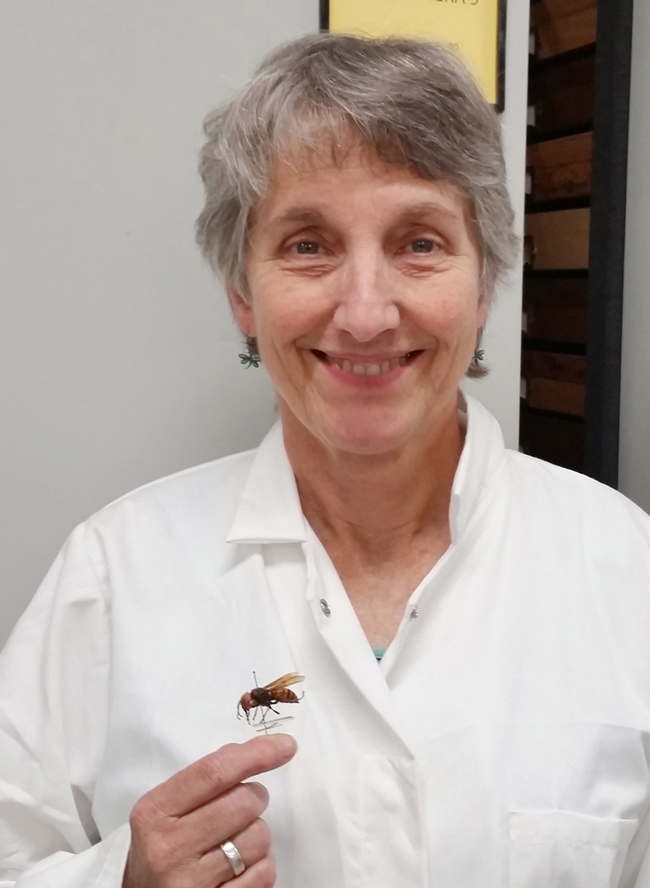
No, they're not back, but they are in the news.
Or specifically, in a podcast.
Noted hymenopterist Lynn Kimsey, director of the Bohart Museum of Entomology and professor of entomology, UC Davis Department of Entomology and Nematology, shed light on the giant insect in an interview with urban entomologist Michael Bentley on his BugBytes podcast. Click here to listen.
Bentley serves as the director of training and education for the National Pest Management Association (NPMA), headquartered in Fairfax, Va., and hosts NPMA's BugBytes. Kimsey, a global authority on wasps, bees and other insects, is a two-term past president of the International Society of Hymenopterists.
They talked about the history of the hornet, its biology, its range, its behavior, its stings, and the news media frenzy.
Basically, two incidents occurred in North America last year. A single colony of the Asian giant hornet (AGH), Vespa mandarinia, was found and destroyed Sept. 18, 2019 in Nanaimo, Vancouver Island, Canada, and a single dead hornet was found Dec. 8, 2019 in nearby Blaine, Wash. “There is no evidence that there are any more hornets in the vicinity of Vancouver or anywhere else on the West Coast," Kimsey told us in a BugSquad piece published on May 5.
Concerned beekeepers, however, worried that the hornets could become established and decimate their hives. Subsequently, entomologists from the Department of Agriculture and Washington State University urged folks to be on the alert and report any sightings.
Suddenly, citizens throughout the country reported seeing scores of "murder hornets," which turned out to be yellow jackets, European paper wasps, hover flies, hoverflies, moths and even a Jerusalem cricket (potato bug). Entomologists fielded all kinds of questions--and still are. Stephane De Greef, a Belgium-born entomology advocate, traveler, field guide, and photographer, called the frenzy "a bloody dumpster fire." He launched a fun (and informative) Facebook page, Is This a Murder Hornet?"
In the podcast, Kimsey relates that the Asian giant hornets are native to Asia, where the residents tolerate them. The beekeeping industry in Washington state, however, was "convinced that they are killing our honey bees," Kimsey told Bentley. "There's no basis in reality as far as I can tell," she said.
The Asian giant hornet is "one of about a dozen or so species in this genus," Kimsey said. She described them as "comically large and menacing looking."
The specimens in the Bohart Museum of Entomology are about 1.5 inches long. "I've never seen one two inches long. But it's a big animal--no question about it."
Bentley also discussed entomologist Justin Schmidt's Sting Pain Index, which rates the painful stings of some 83 hymenopteran species.
Kimsey agreed that the Asian giant hornet "can deliver a lot of venom" and "can sting repeatedly." But in her opinion, "the honey bee sting is the worst."
Other points Kimsey brought out included:
- The Asian giant hornets probably arrived here in cargo ships
- The larvae and pupae are restaurant-fare in some parts of Asia and are quite the delicacy
- The coronavirus pandemic has resulted in fewer cargo ships arriving in the United States from Asia, and thus fewer opportunities for hitchhikers.
Be sure to listen to the educational and entertaining podcast for the details. Or as NPMA wrote: "Where did the Asian giant hornet come from, has it become established in North America, and what threat could it pose to the U.S.? Get answers to these and many more questions in this episode featuring famed hymenopterist, Dr. Lynn Kimsey, as she dispels myths and rumors about this interesting insect."
Related Bug Squad blogs:
- About Those Asian Hornets (May 4, 2020)
- The Hornet Wars: 'A Bloody Dumpster Fire" (May 5, 2020)
- How Do You Say Murder Hornets? Delicious (May 8, 2020)
Matan Shelomi, former graduate student of Lynn Kimsey's and now an assistant professor of entomology at the National Taiwan University in Taipei, Taiwan, enjoys them. - Incredible Work, and Timely, on 22 Species of Hornets (May 12, 2020)
Attached Images:
